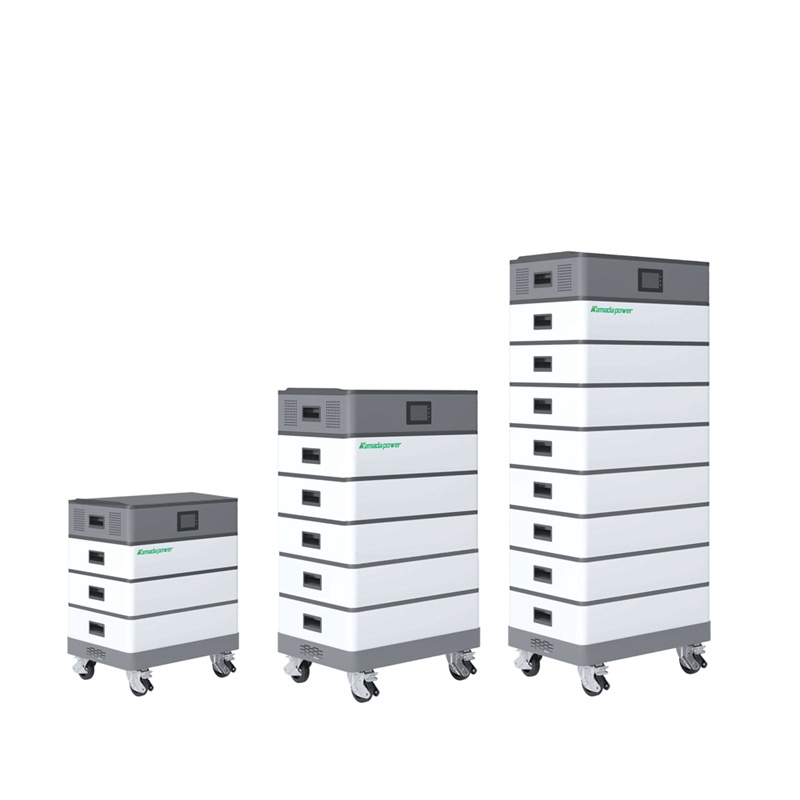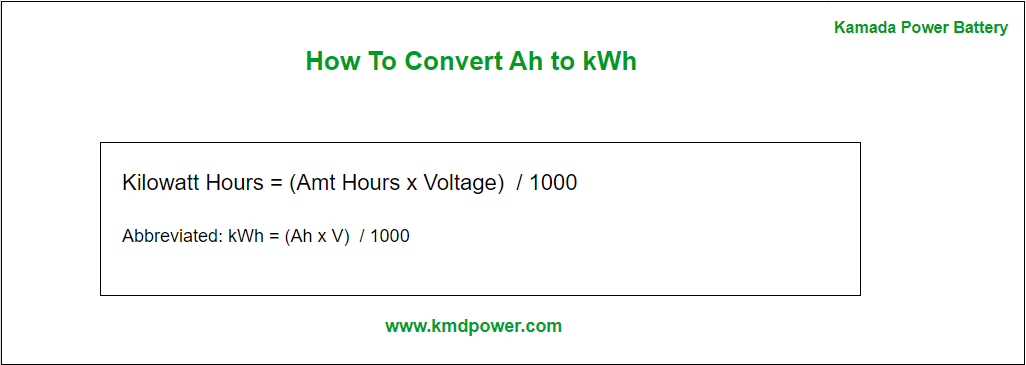What is a Amp-Hour (Ah)
In the realm of batteries, Ampere-hour (Ah) serves as a crucial measure of electrical charge, indicative of a battery’s energy storage capacity. Put simply, an ampere-hour represents the quantity of charge transferred by a steady current of one ampere over the span of an hour. This metric is pivotal in gauging how effectively a battery can endure a specific amperage.
Battery variants, such as lead-acid and Lifepo4, exhibit distinct energy densities and electrochemical characteristics, influencing their Ah capacities. A higher Ah rating signifies a greater reservoir of energy that the battery can deliver. This distinction carries particular significance in off-grid solar setups, where a dependable and ample energy backup is paramount.
What is a Kilowatt-hour (kWh)
In the realm of batteries, a kilowatt-hour (kWh) stands as a pivotal unit of energy, delineating the quantity of electricity generated or consumed over an hour at a rate of one kilowatt. Particularly within the domain of solar batteries, kWh serves as a crucial metric, offering a comprehensive insight into the battery’s overall energy storage capabilities.
In essence, a kilowatt-hour encapsulates the amount of electrical energy utilized or produced within a single hour, operating at a power output of one kilowatt. Conversely, the ampere-hour (Ah) pertains to the measure of electrical charge, representing the volume of electricity coursing through a circuit over the same time frame. The correlation between these units is contingent upon voltage, given that power equates to the product of current and voltage.
How many solar batteries are needed to supply a house with electricity
To estimate the number of batteries needed for your household appliances, consider the power requirements of each appliance and add them together. Below you will find a sample calculation for common household appliances:
Number of batteries Formula:
Number of batteries = total daily energy consumption/battery capacity
Number of batteries Formula Tips:
We use the total capacity of the battery as the basis for calculation here. However, in practical use, factors such as depth of discharge for protection and battery longevity must be taken into account.
Calculating the number of batteries required for a solar power system requires careful consideration of energy consumption patterns, the size of the solar panel array and the desired level of energy independence.
Unter der Annahme, dass die tägliche Nutzungsdauer im Haushalt 5 Stunden beträgt:
| All home equipment combinations |
Power (kWh) (total power * 5 hours) |
Batteries (100 Ah 51.2 V) required |
| Lighting (20 W*5), refrigerator (150 W), television (200 W), washing machine (500 W), heating (1500 W), stove (1500 W) |
19.75 |
4 |
| Lighting (20 W*5), refrigerator (150 W), television (200 W), washing machine (500 W), heating (1500 W), stove (1500 W), heat pump (1200 W) |
25.75 |
6 |
| Lighting (20 W*5), refrigerator (150 W), television (200 W), washing machine (500 W), heating (1500 W), stove (1500 W), heat pump (1200 W), electric vehicle charging (2400 W) |
42,75 |
9 |
Kamada Stackable Battery – your gateway to sustainable energy independence!
Designed with efficiency in mind, this lithium iron phosphate (LiFePO4) battery offers higher energy density and longer life compared to conventional options.
Stackable Battery Highlight:
Tailored to Your Needs: Versatile Stackable Design
Our battery boasts a stackable design, allowing seamless integration of up to 16 units in parallel. This innovative feature empowers you to customize your energy storage system precisely to suit your household’s unique requirements, ensuring reliable power availability whenever you need it.
Integrated BMS for Peak Performance
Featuring a built-in Battery Management System (BMS), our battery guarantees optimal performance, longevity, and safety. With BMS integration, you can trust that your investment in solar energy is safeguarded, providing you with peace of mind for years to come.
Exceptional Efficiency: Enhanced Energy Density
Powered by state-of-the-art LiFePO4 technology, our battery delivers exceptional energy density, providing ample power and extended energy reserves. This ensures consistent and efficient energy storage, enabling you to maximize the effectiveness of your solar system effortlessly.

How Do you Convert Amp Hours (Ah) to Kilowatt Hours (kWh)?
Amp hours (Ah) is a unit of electric charge commonly used to measure the capacity of a battery. It represents the amount of electrical energy a battery can store and deliver over time. One ampere-hour equals a current of one ampere flowing for one hour.
Kilowatt-hours (kWh) is a unit of energy commonly used to measure electricity consumption or production over time. It measures the amount of energy used or generated by an electrical device or system with a power rating of one kilowatt (kW) over one hour.
Kilowatt-hours are commonly used on electricity bills to measure and charge for the amount of energy consumed by households, businesses, or other entities. It’s also used in renewable energy systems to quantify the amount of electricity generated by solar panels, wind turbines, and other sources over a specific period.
To convert from capacity of batteries to energy, the formula could convert Ah to kWh:
Formula: Kilowatt Hours = Amp-Hours × Volts ÷ 1000
Abbreviated Formula: kWh = Ah × V ÷ 1000
For example, if we want to convert 100Ah at 24V to kWh, energy in kWh is 100Ah×24v÷1000 = 2.4kWh.

Ah to kWh Conversion Chart
| Amp Hours |
Kilowatt Hours (12V) |
Kilowatt Hours (24V) |
Kilowatt Hours (36V) |
Kilowatt Hours (48V) |
| 100 Ah |
1.2 kWh |
2.4 kWh |
3.6 kWh |
4.8 kWh |
| 200 Ah |
2.4 kWh |
4.8 kWh |
7.2 kWh |
9.6 kWh |
| 300 Ah |
3.6 kWh |
7.2 kWh |
10.8 kWh |
14.4 kWh |
| 400 Ah |
4.8 kWh |
9.6 kWh |
14.4 kWh |
19.2 kWh |
| 500 Ah |
6 kWh |
12 kWh |
18 kWh |
24 kWh |
| 600 Ah |
7.2 kWh |
14.4 kWh |
21.6 kWh |
28.8 kWh |
| 700 Ah |
8.4 kWh |
16.8 kWh |
25.2 kWh |
33.6 kWh |
| 800 Ah |
9.6 kWh |
19.2 kWh |
28.8 kWh |
38.4 kWh |
| 900 Ah |
10.8 kWh |
21.6 kWh |
32.4 kWh |
43.2 kWh |
| 1000 Ah |
12 kWh |
24 kWh |
36 kWh |
48 kWh |
| 1100 Ah |
13.2 kWh |
26.4 kWh |
39.6 kWh |
52.8 kWh |
| 1200 Ah |
14.4 kWh |
28.8 kWh |
43.2 kWh |
57.6 kWh |
With the development of science and technology, the popularity of lithium-ion batteries, the market for lithium battery performance, price, match made higher requirements, then The following we match the battery specifications for household appliances to analyze the detailed description:
1、I don’t know what size batteries to use to match to my home appliance devices, what should I do?
a:What is the power of a household appliance;
b:To know what the operating voltage of household appliances is;
c:How much time your household electrical equipment has to work;
d:What size are the batteries in household appliances;
Example 1: An appliance is 72W, working voltage is 7.2V, need to work for 3 hours, size is not required, what size of home battery do I need to match?
Power/Voltage=CurrentTime=Capacity As above: 72W/7.2V=10A3H=30Ah Then it is concluded that the matching battery specification for this appliance is: Voltage is 7.2V, Capacity is 30Ah, Size is not required.
Example 2: An appliance is 100W, 12V, needs to work for 5 hours, no size requirement, what size battery do I need to match?
Power / voltage = current * time = capacity As above:
100W / 12V = 8.4A * 5H = 42Ah
Then it is derived from the specifications of the battery matched with this appliance: voltage of 12V, capacity of 42Ah, no size requirements. Note: generally calculated capacity according to the requirements of the appliance, the capacity to give 5% to 10% of the conservative capacity; the above theoretical algorithm for reference, according to the actual matching of home appliances home battery use effect shall prevail.
2、Household appliances are 100V, how many V is the operating voltage of the battery?
What is the working voltage range of household appliances, then match the household battery voltage.
Remarks: Single lithium-ion battery: Nominal voltage: 3.7V Operating voltage: 3.0 to 4.2V Capacity: can be high or low, according to the actual requirements.
Example 1: The nominal voltage of a home appliance is 12V, so how many batteries need to be connected in series to most closely approximate the voltage of the home appliance?
Appliance voltage/nominal battery voltage = number of batteries in series 12V/3.7V=3.2PCS (it is recommended that the decimal point can be rounded up or down, depending on the voltage characteristics of the appliance) Then we set the above as a conventional situation for the 3 strings of batteries.
Nominal voltage: 3.7V * 3 = 11.1V;
Operating voltage: (3.03 to 4.23) 9V to 12.6V;
Example 2: The nominal voltage of a home appliance is 14V, so how many batteries need to be connected in series to most closely approximate the voltage of the appliance?
Appliance voltage/nominal battery voltage = number of batteries in series
14V/3.7V=3.78PCS (it is recommended that the decimal point can be rounded up or down, depending on the voltage characteristics of the appliance) Then we set the above as 4 strings of batteries according to the general situation.
Nominal voltage is: 3.7V * 4 = 14.8V.
Operating voltage: (3.04 to 4.24) 12V to 16.8V.
3、Home appliances need regulated voltage input, what kind of battery to match?
If voltage stabilization is required, there are two options available: a: add a step-up circuit board on the battery to provide voltage stabilization; b: add a step-down circuit board on the battery to provide voltage stabilization.
Remarks: There are two disadvantages to reach the voltage stabilization function:
a: input/output need to be used separately, can not be in the same interface output input;
b: There is a 5% energy loss
Amps to kWh: Frequently Asked Questions (FAQs)
Q: How do I convert amps to kWh?
A: To convert amps to kWh, you need to multiply the amps (A) by the voltage (V) and then by the time in hours (h) the appliance operates. The formula is kWh = A × V × h / 1000. For example, if your appliance draws 5 amps at 120 volts and operates for 3 hours, the calculation would be: 5 A × 120 V × 3 h / 1000 = 1.8 kWh.
Q: Why is it important to convert amps to kWh?
A: Converting amps to kWh helps you understand the energy consumption of your appliances over time. It allows you to estimate the electricity usage accurately, plan your energy needs efficiently, and select the appropriate power source or battery capacity for your requirements.
Q: Can I convert kWh back to amps?
A: Yes, you can convert kWh back to amps using the formula: amps = (kWh × 1000) / (V × h). This calculation helps you determine the current drawn by an appliance based on its energy consumption (kWh), voltage (V), and operating time (h).
Q: What are some common appliances’ energy consumption in kWh?
A: Energy consumption varies widely depending on the appliance and its usage. However, here are some approximate energy consumption values for common household appliances:
| Appliance |
Energy Consumption Range |
Unit |
| Refrigerator |
50-150 kWh per month |
Month |
| Air conditioner |
1-3 kWh per hour |
Hour |
| Washing machine |
0.5-1.5 kWh per load |
Load |
| LED light bulb |
0.01-0.1 kWh per hour |
Hour |
Final Thoughts
Understanding kilowatt-hour (kWh) and amp-hour (Ah) is essential for solar systems and electric appliances. By evaluating the battery capacity in kWh or Wh, you can determine the appropriate solar generator for your needs. Converting kWh to amps aids in selecting a power station that can provide continuous electricity to your appliances over an extended period.